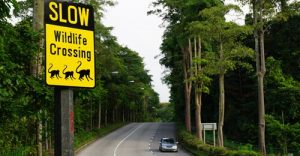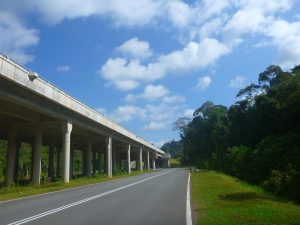The Urban Doggos team proposes an environmental campaign to improve ethnocultural inclusivity in Singapore urban parks. They aim to find a balance between citizen satisfaction and ecological concerns. Please follow this link to the full research proposal and environmental campaign here.
urban ecology
Sustainable Singapore: Dream vs Reality
The city-state of Singapore is often portrayed as a utopia in terms of quality of life, economy, and sustainability. In fact, the Sustainable Cities Index 2016 ranked it first in Asia and second globally. On paper, the Sustainable Singapore Blueprint looks ideal. But environmental utopian models such as ‘eco-cities’ have poor track records when it comes to implementation. My question is: has Singapore managed to turn these environmental dreams into reality?
Roadkills in Singapore—one too many?
As we all know, the fragmentation of natural habitats is one of the many repercussions brought about by urbanisation. Roads especially, have both positive and negative impacts, the latter being the increased likelihoods of roadkill and the former being increased connectivity.
While the benefits for us are clear, there has yet to be any significant benefits for wildlife in general (Fahrig & Rytwinski, 2009).
Singapore is known for its extensive green cover, where even the roads and highways are lined with trees and shrubs. Although this helps to ameliorate the impacts of the Urban Heat Island (UHI) effect, it might inadvertently attract more animals to the vicinity, increasing the chances of roadkill; with the ubiquity of street lights in Singapore further exacerbating the issue.
Roadkills in Mandai
The recent reports of roadkills (a Leopard cat, Sunda pangolin and Sambar deer) showed a worrying trend [Animals affected by Mandai park works: Wildlife groups; March 24, 2018]. Mammals are uncommon in Singapore, with small mammals making up the majority of the population. It does not help that smaller vertebrates—which are already threatened by habitat loss and fragmentation—were found to be at greater risk of roadkill (Rodríguez-Castro et al., 2017).
It was heartening to know that in addition to the proposed eco-link bridge, several other structures (e.g. green acoustic wall barriers) that protect and facilitate the movement of wildlife would be built, including the retention of existing culverts (MPH, 2016). However, current mitigation measures—like road signs and speed bumps—are still inadequate as wildlife in the vicinity have no structures to aid their movement across the temporary fauna crossing, rendering them vulnerable to vehicular strikes.
Apart from mammals, birds should be taken into consideration during the implementation of mitigation measures as well. Despite (most birds) having the ability to fly, some birds are territorial and rely on their songs to find potential mates, thus noise pollution would affect their hearing, forcing them to go closer to roads. Light pollution from street lights and vehicles pose threats too, as migratory birds often rely on starlight for navigation, hence rendering them vulnerable to collisions (Glista et al., 2009).
Animals in the vicinity are already facing significant levels of stress from the construction works and shepherding; ergo, relevant authorities should not be complacent, and look into enhancing roadkill mitigation measures by consulting nature groups for further improvements. Emulating its predecessor (Eco-Link @ BKE) should be a given, but there are definitely areas that could still be improved upon. Beneficial design elements from other wildlife crossings, like the Sungai Yu wildlife corridor and Banff National Park, should be taken into consideration for incorporation into Mandai, as well as future projects.
If we truly wish to bask in the beauty of nature and reap its benefits, the onus is on us to retain, or better yet, enhance the connectivity in our highly disturbed environment, with inconveniences borne by us and not the wildlife.
Towards a “car-lite” society
On the other hand, the suggestion to designate Mandai Lake Road as a ‘car-lite’ zone is a feasible one and should be taken into consideration [Make Mandai vehicle-light to reduce roadkill; Mar 29, 2018]. After all, Singapore is in the process of shifting to a ‘car-lite’ society, and has in fact designated some areas of the upcoming Tengah estate to be ‘car-free’ [New Tengah HDB town heavy on greenery, light on cars; Sep 9, 2016]. The Jurong Lake District has also been designated as a ‘car-lite’ area as well [Fewer car parks, more cycling paths in Jurong Lake District; Aug 25, 2017]. With a car-lite society, roadkills would hopefully be reduced, if not kept to a minimum.
Another suggestion would be abolishment of the car park in the East Arrival Node, which is situated near the Central Catchment area (MPH, 2016). Having a single carpark outside of the sensitive Central Catchment area, with designated buses shuttling visitors in and out of the wildlife park would significantly reduce traffic along Mandai Lake Road, and hopefully, roadkill incidents too.
Roadkills, regardless of the conservation status of the animal, are detrimental to Singapore’s sensitive ecosystems. For this reason, I implore Mandai Park Holdings (MPH), the parent company behind Wildlife Reserves Singapore (WRS), to make roadkill statistics available to nature organisations and institutions, so that they can analyse the data and provide constructive feedback. In highly urbanised Singapore, incidents of roadkill are bound to occur, even with robust mitigation measures. I hope that authorities can learn from the mistakes of Mandai, and put more measures in place for the upcoming Tengah estate, in order to best preserve what precious little wildlife Singapore has left.
References
Fahrig, L. & Rytwinski T. (2009). Effects of roads on animal abundance: an empirical review and synthesis. Ecology and Society 14(1): 21. Retrieved from: http://www.ecologyandsociety.org/vol14/iss1/art21/
Glista, D. J., DeVault, T. L., & DeWoody, J. A. (2009). A review of mitigation measures for reducing wildlife mortality on roadways. Landscape and Urban Planning. http://doi.org/10.1016/j.landurbplan.2008.11.001
Mandai Park Holdings [MPH]. (2016). Environmental Impact Assessment (EIA) report. Mandai Park Holdings. Available at: https://www.mandai.com/download/pdf/Final%20EIA_Main%20Chapters.pdf (Accessed 14 April 2018).
Rodríguez-Castro, K. G., Ciocheti, G., Ribeiro, J. W., Ribeiro, M. C., & Galetti, P. M. (2017). Using DNA barcode to relate landscape attributes to small vertebrate roadkill. Biodiversity and Conservation, 26(5), 1161–1178. http://doi.org/10.1007/s10531-017-1291-2



